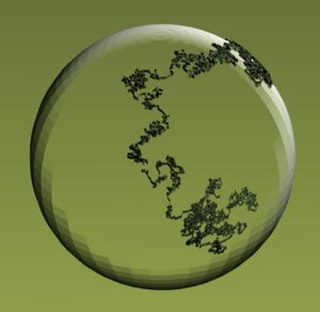Related Research Articles

In probability theory and related fields, a stochastic or random process is a mathematical object usually defined as a family of random variables. Historically, the random variables were associated with or indexed by a set of numbers, usually viewed as points in time, giving the interpretation of a stochastic process representing numerical values of some system randomly changing over time, such as the growth of a bacterial population, an electrical current fluctuating due to thermal noise, or the movement of a gas molecule. Stochastic processes are widely used as mathematical models of systems and phenomena that appear to vary in a random manner. They have applications in many disciplines such as biology, chemistry, ecology, neuroscience, physics, image processing, signal processing, control theory, information theory, computer science, cryptography and telecommunications. Furthermore, seemingly random changes in financial markets have motivated the extensive use of stochastic processes in finance.

The concept of a random sequence is essential in probability theory and statistics. The concept generally relies on the notion of a sequence of random variables and many statistical discussions begin with the words "let X1,...,Xn be independent random variables...". Yet as D. H. Lehmer stated in 1951: "A random sequence is a vague notion... in which each term is unpredictable to the uninitiated and whose digits pass a certain number of tests traditional with statisticians".

Queueing theory is the mathematical study of waiting lines, or queues. A queueing model is constructed so that queue lengths and waiting time can be predicted. Queueing theory is generally considered a branch of operations research because the results are often used when making business decisions about the resources needed to provide a service.

A Markov chain is a stochastic model describing a sequence of possible events in which the probability of each event depends only on the state attained in the previous event. A countably infinite sequence, in which the chain moves state at discrete time steps, gives a discrete-time Markov chain (DTMC). A continuous-time process is called a continuous-time Markov chain (CTMC). It is named after the Russian mathematician Andrey Markov.

Andrey Nikolaevich Kolmogorov was a Soviet mathematician who made significant contributions to the mathematics of probability theory, topology, intuitionistic logic, turbulence, classical mechanics, algorithmic information theory and computational complexity.
Stochastic refers to a randomly determined process. The word first appeared in English to describe a mathematical object called a stochastic process, but now in mathematics the terms stochastic process and random process are considered interchangeable. The word, with its current definition meaning random, came from German, but it originally came from Greek στόχος (stókhos), meaning 'aim, guess'.
In probability theory, a Lévy process, named after the French mathematician Paul Lévy, is a stochastic process with independent, stationary increments: it represents the motion of a point whose successive displacements are random, in which displacements in pairwise disjoint time intervals are independent, and displacements in different time intervals of the same length have identical probability distributions. A Lévy process may thus be viewed as the continuous-time analog of a random walk.

In probability theory, in particular in the study of stochastic processes, a stopping time is a specific type of “random time”: a random variable whose value is interpreted as the time at which a given stochastic process exhibits a certain behavior of interest. A stopping time is often defined by a stopping rule, a mechanism for deciding whether to continue or stop a process on the basis of the present position and past events, and which will almost always lead to a decision to stop at some finite time.
A jump process is a type of stochastic process that has discrete movements, called jumps, with random arrival times, rather than continuous movement, typically modelled as a simple or compound Poisson process.

Albert Nikolayevich Shiryaev is a Soviet and Russian mathematician. He is known for his work in probability theory, statistics and financial mathematics.
A stochastic simulation is a simulation of a system that has variables that can change stochastically (randomly) with individual probabilities.

In statistical analysis, change detection or change point detection tries to identify times when the probability distribution of a stochastic process or time series changes. In general the problem concerns both detecting whether or not a change has occurred, or whether several changes might have occurred, and identifying the times of any such changes.
In statistical theory, the field of high-dimensional statistics studies data whose dimension is larger than dimensions considered in classical multivariate analysis. High-dimensional statistics relies on the theory of random vectors. In many applications, the dimension of the data vectors may be larger than the sample size.
This page lists articles related to probability theory. In particular, it lists many articles corresponding to specific probability distributions. Such articles are marked here by a code of the form (X:Y), which refers to number of random variables involved and the type of the distribution. For example (2:DC) indicates a distribution with two random variables, discrete or continuous. Other codes are just abbreviations for topics. The list of codes can be found in the table of contents.
In probability theory and statistics, Campbell's theorem or the Campbell–Hardy theorem is either a particular equation or set of results relating to the expectation of a function summed over a point process to an integral involving the mean measure of the point process, which allows for the calculation of expected value and variance of the random sum. One version of the theorem, also known as Campbell's formula, entails an integral equation for the aforementioned sum over a general point process, and not necessarily a Poisson point process. There also exist equations involving moment measures and factorial moment measures that are considered versions of Campbell's formula. All these results are employed in probability and statistics with a particular importance in the theory of point processes and queueing theory as well as the related fields stochastic geometry, continuum percolation theory, and spatial statistics.

In probability, statistics and related fields, a Poisson point process is a type of random mathematical object that consists of points randomly located on a mathematical space. The Poisson point process is often called simply the Poisson process, but it is also called a Poisson random measure, Poisson random point field or Poisson point field. This point process has convenient mathematical properties, which has led to it being frequently defined in Euclidean space and used as a mathematical model for seemingly random processes in numerous disciplines such as astronomy, biology, ecology, geology, seismology, physics, economics, image processing, and telecommunications.
The phenomenon of statistical stability, one of the most surprising physical phenomena, is the weakness of the dependence of statistics on the sample size, if this size is large. This effect is typical, for example, for relative frequencies of mass events and averages. This phenomenon is widespread and so can be regarded as a fundamental natural phenomenon.

Aleksandr Alekseevich Borovkov is a Russian mathematician.

Jean Jacod is a French mathematician specializing in Stochastic processes and probability theory. He has been a professor at the Université Pierre et Marie Curie. He has made fundamental contributions to a wide range of topics in probability theory including stochastic calculus, limit theorems, martingale problems, Malliavin calculus and statistics of stochastic processes.
References
- H. Vincent Poor and Olympia Hadjiliadis (2008). Quickest Detection (First ed.). Cambridge: Cambridge University Press. ISBN 978-0-521-62104-5.
- Shiryaev, Albert N. (2007). Optimal Stopping Rules. Springer. ISBN 978-3-540-74010-0.
- Gapeev, P.V. (2005). "The disorder problem for compound Poisson processes with exponential jumps". Ann. Appl. Probab. 15 (1A): 487–499. arXiv: math/0503481 . doi:10.1214/105051604000000981.
- Kolmogorov, A. N., Prokhorov, Yu. V. and Shiryaev, A. N. (1990). Methods of detecting spontaneously occurring effects. Proc. Steklov Inst. Math. 1, 1–21.
| This probability-related article is a stub. You can help Wikipedia by expanding it. |